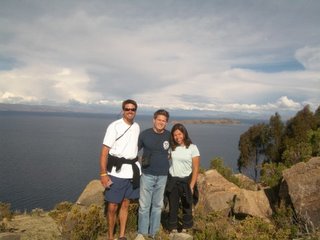Copacobana, Bolivia


Lake Titicaca is the world's highest navigable lake at 12,500 ft above sea level, in the Andes Mountains, astride the border between Peru and Bolivia. It is also the second largest lake of South America.
My new friend Mark had already left for Bolivia when I returned from the Inca Trail because he was on a tight schedule to make to Brazil to meet up with his girlfriend. I figured it was doubtful that we would be able to find each other in Copacabana given that he had a head start but figured I would give it a shot anyway since I was was headed that direction. I took a bus to Puno, which is the city on the Peruvian side of Lake Titicaca. I asked the woman at the tourist office if I could make it to Copacabana - the city on the Bolivian side of Lake Titicaca - and she gave me a strange look. But she pointed me in the direction of another bus station to take a small local bus to the border town of Yunguyo, where I could transfer buses to Copacabana. I was the only tourist on the bus and had the pleasure of sitting next to a very rancid smelling man. I spent the next 2 1/2 hours with my head half out the window so that I could breathe. I was cutting it very close and wasn't sure I would make it to the border before the immigration office closed. I was even more nervous when the saw the town of Yunguyo, because it didn't appear to have much in terms of accommodations. The bus dropped us off in this middle of nowhere town, but there wasn't any bus to transfer to. All that was there were bicycle taxis - not seeing too many options and having no clue where I was, I took one to the border, where I walked across and took a regular taxi to Copacabana.
Copacabana is a small, quaint, hippie-like town, and it appears that more than one tourist enjoyed it enough to stay permanently. Shortly after I arrived in Copacabana, I ran into Mark and Stu. Mark and Stu had experienced some frustrations of travel together when their bus got a flat, and it resulted in a rather long journey to Bolivia. We went for a drink and then later went for dinner at a great restaurant. The owner was from Bolivia but lived in the U.S. for a number of years before tiring of the fast-paced American life and returning to Copacabana. He chatted with us about his family and the people in Bolivia. He was so incredibly happy and in love, it was difficult not to be just a little envious of the simplicity of his life.
The following day the three of us went to one of the islands on Lake Titicaca, Isla del Sol, otherwise known as "Island of the Sun". It is a mountainous island dotted with small villages and doesn't have much in terms of accommodations other than a few hostels and simple restaurants. When eating at these restaurants, we felt like we were walking into a family's dining room and asking for dinner. We spent the night, and hiked from the North part of the island the following day. There were some good trails, but we choose a more adventurous route and made our own "path" over the mountainous terrain.
Stu left for Cusco, and Mark and I stayed one more night in Copacabana before heading to Arequipa, Peru. We returned to our favorite restaurant with another friend (Julian) that we had met the first night, and this time the owner of the restaurant gave us free shots of common Bolivian liquor. Already feeling the effects of his generosity, we headed to another popular watering hole after dinner. We met a couple from England and hung out with them for the rest of the night. The woman was in her early twenties; her energy and ability to drink provided a good reminder of the fact that I am no longer in my twenties. We stayed out until the wee hours of the morning, did some shopping, and then hopped on a bus for Arequipa.

0 Comments:
Post a Comment
<< Home